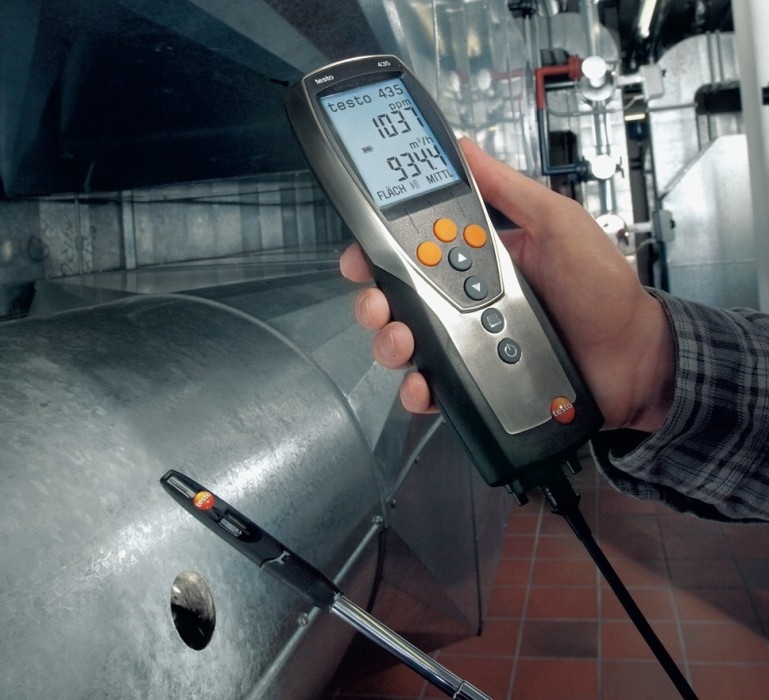The passport of the ventilation system is its obligatory technical document, showing how efficient the system is. It contains data on the installed equipment, its technical characteristics, real characteristics issued by the ventilation system, their deviations from the project. It includes air measurement data and a ventilation system diagram with marked metering points.
The passport reflects the state at the time of its compilation of equipment, ventilation systems. Its presence in the ventilation system indicates the possibility of operating this system.
When the passport of the ventilation system is filled
Issue passports of ventilation systems in the following cases:
- after completion of commissioning at the new facility;
- after the loss of old passports;
- after a deep reconstruction of the ventilation system, which includes not just replacing equipment, but changing the purpose of the system, altering the duct system, redeveloping the rooms.
What is included in the passport when preparing technical documentation
The passport of the ventilation system is part of the technical documentation drawn up during the commissioning of the system. It includes:
- Draft of AE with actual changes, certified signatures and seals;
- certificates and technical passports of components of ventilation systems;
- instruction manual (a brief instruction can be applied to the passport of the ventilation unit);
- ventilation installation passport;
- act of hidden work;
- acceptance certificate;
- The act of individual testing of ventilation equipment.
Who will make the passport for the ventilation system
According to clause 8.3.1. set of rules, before putting the ventilation systems into operation, the installation organization transfers the work reflected in the act, and the commissioning organization must carry out commissioning of the systems. In practice, often all of this work, as well as filling out the passport of the ventilation system (an example is given in the article), is done by the organization that carried out the installation. For the customer it is easier and cheaper. It turns out that the installers check themselves. It is more correct to call commissioning organizations. They must also issue passports and verify the compliance of the assembled systems with the project, draw the customer's attention to the shortcomings of the installed systems, draw up instructions for their elimination. Laboratories and specialized organizations are invited to accept ventilation systems more often.
What does the ventilation system passport look like
The form for the passport of the ventilation system approved in regulatory documents is mandatory. This is a short option. When issuing passports, he is often used. It happens that organizations based on it develop their own, more detailed, forms. The question is how to perceive the passport of the ventilation system. Will it be needed only for putting the system into operation, or will it become a document that will reflect the "life" of the system (equipment replacement, repairs, maintenance, periodic checks). Operators (especially those with large ventilation facilities), on the basis of the mandatory form, can develop what is convenient for themselves either independently or by contacting specialized organizations.
Filling the passport of the ventilation system using an example
Consider the existing passport of the ventilation system, sample filling. This is an air supply unit with air purification, water heating, freon cooling and sound attenuation.
In this example, only filling out the sheets recommended by the passport form guidelines will be shown.
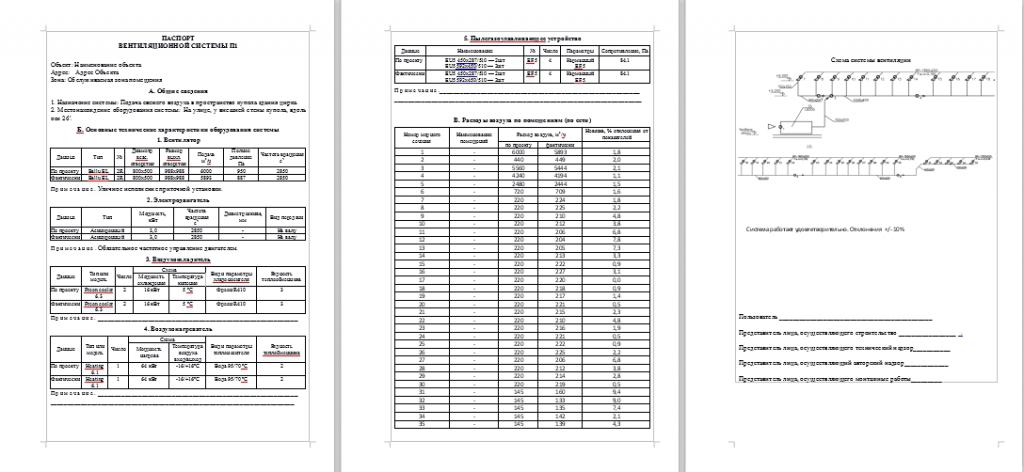
Total information. Section A
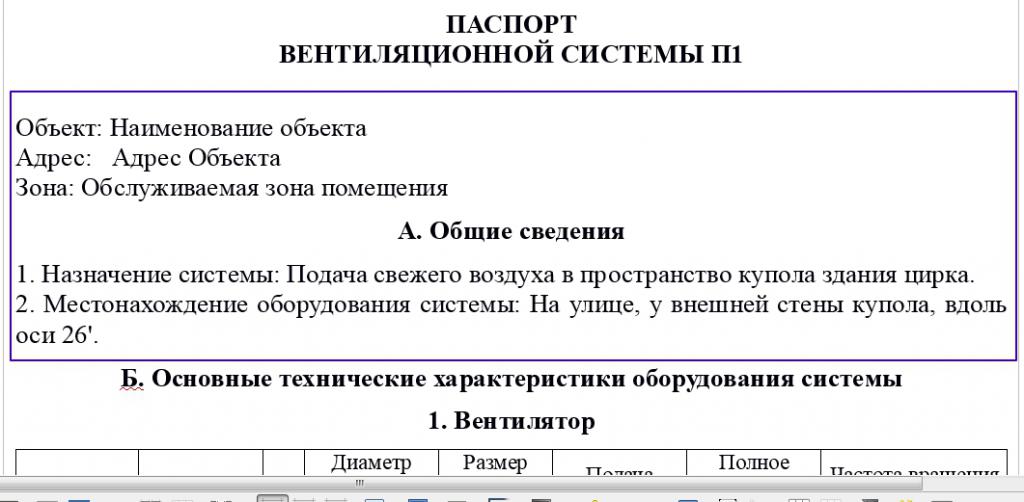
It is indicated on which ventilation system the passport is made. Supply systems are indicated by the letter "P", exhaust systems - "B", supply and exhaust systems - "PV". The system number is also indicated. For example, P 1, B 3, P 2, etc. The system number usually corresponds to the system number in the OB project. Also this number is applied with paint on the system case, on which the passport is issued.
Indicated:
- name of the object (it corresponds to the design name of the object);
- Address of the object;
- zone, workshop, premises (name of the premises served by the system);
- often a plan of these rooms is attached to the passport with a diagram of the outgoing ducts and grilles (this is for convenience).
Having only axonometry on hand, in a few years it will be necessary to raise the project in order to determine how the air ducts pass.
Section A reflects general information: purpose of the system; brief description of the system; what does where it delivers or where it draws air; location of system equipment; A brief description of where the equipment is installed.
Section B. Equipment Specifications
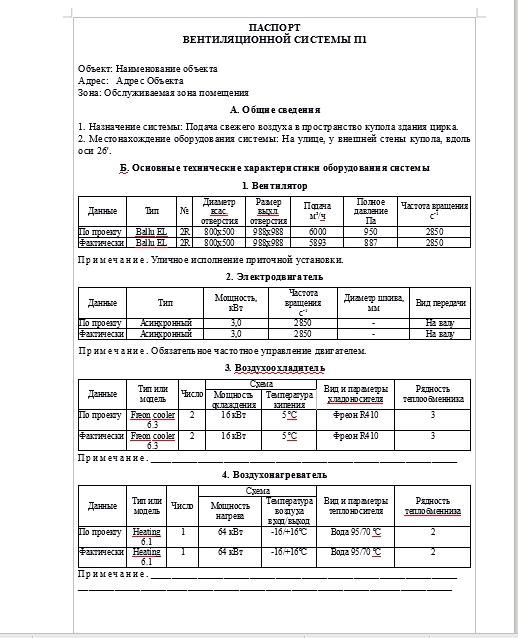
It reflects the main technical characteristics of the equipment, fills in the tables with the characteristics of the system parts, design and actually installed. The data of the project and the data of actual measurements (these are the results of the acts of measurements) are entered in the columns of the tables, notes are filled out.
The following tables are included in the passport:
- Fan. Testing of fans is carried out simultaneously with testing of ventilation networks working with them.
- Electric motor
- Air cooler.
- Air heater.
- Dust and gas capture devices.
They include the marking and characteristics of the equipment incorporated in the project, as well as the marking of the actually installed equipment and the actual characteristics that it gives out during operation. Replacing equipment with a similar one that provides the same air exchange parameters is normal practice. However, full compliance of the installed equipment with design is often required. In the passport of the ventilation system under consideration, an example of filling is given for this particular case.
For passports of exhaust ventilation systems, all tables are not needed. There, for example, there will be no table on the heat exchanger, air cooler. In this case, they can either be removed from the passports or left blank, marked “not provided”.
Section B. Air Consumption
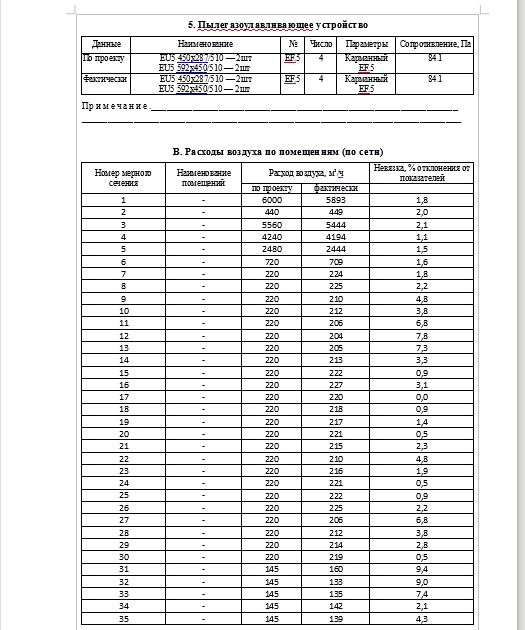
Section B "Indoor air flow (network)" is filled out on the basis of measurements. For measurements are acts of aerodynamic testing. They are included in the documents necessary for commissioning, but may not be attached to the passport. When filling out the table of section B, the following shall be indicated:
- numbers of points where section measurements are taken;
- name of the premises;
- air consumption (design and actual);
- discrepancy - the percentage of deviation from the indicators (the set of rules sets the discrepancy +/- 8% of the required values, but in practice it is very difficult to obtain such a percentage of discrepancy).
Axonometric ventilation scheme
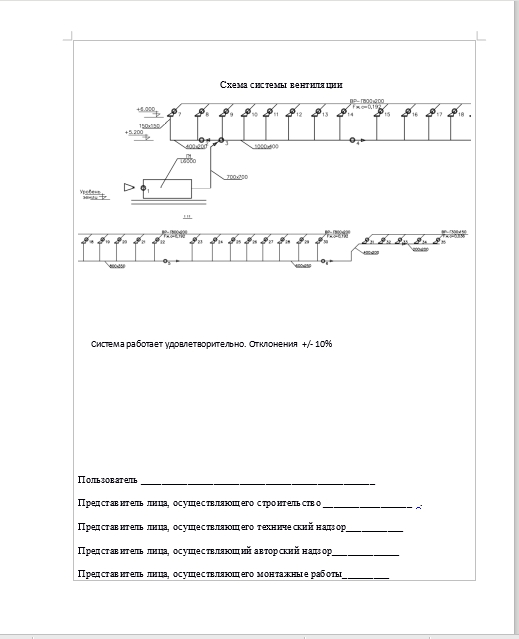
The next section of the passport is the ventilation scheme. It indicates the points of measurement, identified and agreed with the customer deviations from the project. The numbers of the measuring points in the diagram correspond to the numbers in the air flow rate table. The example diagram shows the cross-sections of the ducts, their mounting height, the number and type of ventilation grilles, and the location of the supply system.
How long is the passport of the ventilation system
This document is issued once for the entire service life. It is perpetual. Systems without a passport are not allowed to operate.
Another thing is that it is necessary to periodically check the effectiveness, conduct tests and regulate the operating ventilation systems.According to STO NOSTROY 2.24.2-2011, the frequency of checks of the status of ventilation systems is determined by standards. It also depends on production technology. In any case, tests should not take place less than once every 3 years.
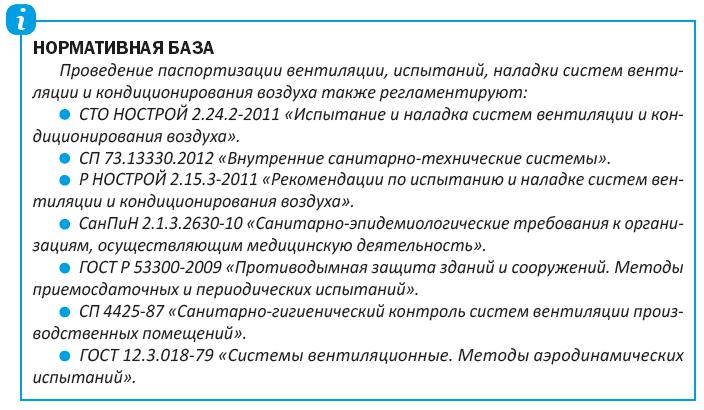
For existing ventilation systems, the frequency of verification and adjustment will be:
- for rooms with hazards of class 1 and class 2 - 1 time per month;
- for local ventilation systems (exhaust and supply) - 1 time per year;
- for natural and general mechanical exchange - 1 time in 3 years.
The administration of organizations is responsible for the work. As a result of the work, make the necessary measurements. The data is entered in the passport, or drawn up in a separate act, which is joked with the passport. The main criterion for the quality of work is the reliability of measurements and the accuracy of adjustment of the system, the safety of operation of the ventilation system, its ability to maintain specified microclimate parameters.
